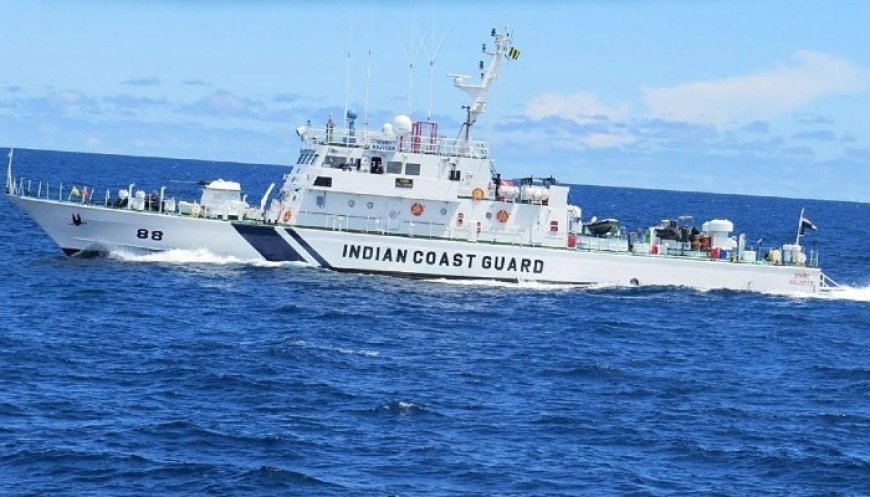High‑Seas Heroics: Indian Coast Guard Rescues US Sailors Near Nicobar Islands
The Indian Coast Guard rescued a distressed U.S.-flagged yacht off Nicobar Islands today, showcasing maritime readiness and cross-border coordination.

By Ronald Kapper
Published: July 11, 2025
Introduction
A dramatic rescue operation unfolded today as the Indian Coast Guard (ICG) came to the aid of two U.S. nationals stranded aboard a sailing yacht approximately 53 miles south of the Nicobar Islands. The vessel, a U.S.-flagged sailing yacht named Sea Angel, suffered a complete propulsion failure amid raging seas. The swift response by ICG Ship Rajveer, dispatched at the behest of the U.S. Consulate in Chennai, highlights India’s operational readiness in maritime safety and underscores its role as a responsible regional power YouTube+7www.ndtv.com+7The Indian Express+7.
The Rescue: What Happened at Sea
Late on July 10, the yacht issued a distress alert after losing both sail and engine propulsion. Its propeller was fouled by debris, and heavy winds battered the vessel, effectively stranding the crew—one American and one Turkish—52 nautical miles southeast of Indira Point near Campbell Bay. Acting promptly, the Maritime Rescue Coordination Centre (MRCC) in Port Blair, working alongside the U.S. consulate, tasked ICG Ship Rajveer with the rescue mission The Indian Express+2Press Information Bureau+2The Indian Express+2.
Despite the ferocious sea state, Rajveer navigated treacherous waters, located the yacht in distress, and confirmed both individuals were uninjured but fatigued. By the morning of July 11, Sea Angel had been safely towed into the sheltered harbour at Campbell Bay, ensuring the crew’s well-being .
Focus on Seamanship and Operational Preparedness
The rescue serves as a real-time showcase of the ICG's extensive capabilities, honed through years of patrol, SAR (search-and-rescue) missions, and disaster relief initiatives in the Indian Ocean region. Notably:
-
Rapid deployment by ICG Ship Rajveer, equipped for coastal and offshore operations.
-
Robust coordination across MRCC Port Blair, the U.S. consulate in Chennai, and ICG command—seamless multi-agency collaboration.
-
Skilled seamanship during open-ocean towing under hostile conditions.
The ICG’s adept handling of this crisis echoes its performance during past operations such as tsunami relief in 2004, affirming India’s status as a maritime security provider The Indian Express+4Press Information Bureau+4The Times of India+4Press Information Bureau+4www.ndtv.com+4The Indian Express+4.
India’s Maritime Strategy in Action
India’s maritime approach prioritizes Save Our Seas (SOS) protocols and cross-border cooperation. With an 182-ship fleet and 78 aircraft, the ICG has been rapidly expanding its footprint, particularly in the Andaman & Nicobar region—long seen as both strategic buffer and vulnerable archipelago Wikipedia. Budget allocations in 2025–26 support this growth, funding patrol vessels, interceptor boats, and coastal surveillance systems.
The execution of this rescue reaffirms the ICG’s core mission: safeguarding lives at sea, enforcing coastal laws, and projecting India’s soft power through timely humanitarian intervention.
Diplomatic Dimensions of the Rescue
Though a routine humanitarian operation, the rescue carries significant diplomatic nuance, reinforcing India’s reliability in safeguarding foreign nationals. The swift response to the U.S. consulate’s distress message enhances India–U.S. strategic relations, especially within the Indo-Pacific security umbrella. For the U.S., it validates New Delhi’s alignment with regional norms on maritime crisis response.
It also resonates within the broader Indian Ocean narrative: India emerged as a dependable regional partner—from rescuing fishermen and stranded sailors to participating in counter-piracy and humanitarian missions.
After the Rescue: What Comes Next
Following the rescue, the yacht and its crew were transported to Campbell Bay, where local authorities offered logistical aid, medical checks, and repatriation arrangements. As per ICG standard operating procedures, Sea Angel will likely undergo an inspection before returning to active service.
India’s surge in maritime patrols—including MRCC centres in Mumbai, Chennai, and Port Blair—reinforces a framework ready for future incidents and exemplifies proactive coastal management The Indian Express+2Press Information Bureau+2The Indian Express+2.
Learning from ICG’s Operational Doctrine
The rescue is not only a success story; it offers insight into the ICG’s operational doctrine:
-
Advance readiness, ensuring mission-capable response 24/7 across coast guard and naval bases.
-
Multi-agency protocols — coordinated responses with consulates, Defence Ministry units, and regional law enforcement.
-
Training and resource allocation, involving advanced survival simulations, towing maneuvers, and deep-sea SAR drills—skills exemplified by crews aboard ICG Ship Rajveer.
As the ICG scales its capabilities, such missions become testbeds for future crisis responses, be they mechanical failures, piracy, or environmental hazards like oil spills.
Strategic Significance for Indo-Pacific Security
The rescue reinforces India’s evolving Indo-Pacific policy, where it plays the dual role of a blue-water navy enabler and a net security provider. By ensuring the safety of all seafaring nationals—regardless of origin—India signals its readiness to uphold safe maritime order and uphold freedom of navigation.
Moreover, the demonstration of effective civil-military synergy, transparent cross-border rescue engagement, and operational proficiency bolsters India’s credentials as a regional leader in maritime governance.
Conclusion: A Maritime Success Story
This action-packed rescue mission shines a spotlight on India’s maritime evolution. It is more than just the fortunate safe return of two sailors—it is:
-
Proof of deep operational readiness and ICG’s logistic depth.
-
An exercise of policy-driven diplomacy, signaling India’s commitment to regional safety.
-
A milestone in coast guard professionalism, reinforcing readiness to manage future challenges across vast territorial waters.
As India continues to fortify its maritime infrastructure, including more vessels, aircraft, and coastal command centres, sailors, traders, and travelers can take added reassurance from the ICG’s increasing responsiveness. For the two U.S. sailors and their team aboard Sea Angel, the mission means survival; for India, it means a cross-border rescue that underscores maritime competence and goodwill.











